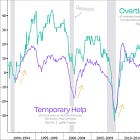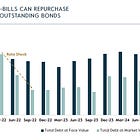Where does all the sanctioned oil go?
And 5 other charts and missives about trade and 'geopolitics'
a monopsony for sanctioned oil
India, feeling the burn
Viet-NOW
More FDI for US, and less for THEM
👉👉👉Reminder to sign up for the Weekly Recap only, if daily emails is too much. Find me on twitter, for more fun. 👋👋👋Random Walk has been piloting some other initiatives and now would like to hear from broader universe of you:
(1) 🛎️ Schedule a time to chat with me. I want to know what would be valuable to you.
(2) 💡 Find out more about Random Walk Idea Dinners. High-Signal Serendipity.Where does all the sanctioned oil go?
Has anyone had a frenemy quite like China?
We sanction Iranian, Venezuelan and Russian oil, and China is like “cool, we’ll take it. All of it.”
China is the only buyer of Iranian and Venezuelan oil;
China and India divide Russian oil between them (and then India refines it and sells it back to Europe).
It’s a weird thing, sanctions.
I mean, it’s not like it’s some surprise or secret (hopefully) that China would go ahead and buy all the sanctioned oil, likely at a discount. That means that we know that the only way to really stop the oil from flowing is to embargo it, which presumably we won’t do because it would really piss China off, and/or maybe because the consequences would be too severe on the sanctioned countries.
So, is China our friend in that scenario, for keeping the lights on in Iran, but also imposing a discount, or is China our rival, by undermining effective sanctions? Probably a bit of both, I would think.
And what does that make India, which isn’t exactly super-tight with China?1 I guess something of a frenemy too, but a little heavier on the friend.
Take this for what you will:
Inbound ocean freight from India is down 35% since August.
Trump wasn’t kidding about the whole “stop buying Russian oil,” thing, I suppose.
It’s all very choreographed, though, and no one ever means what they say, or does what they do for the reasons that they claim, which is, I suppose true of all politics, but especially “geopolitics.”
ICYMI
Vietnow
Random Walk has made this observation before, but the latest visual is once again striking, so I will make it again.
When we stop importing stuff from China, China routes that stuff through Vietnam, and then we import it from there.
Take the example of cheap tchotchkes on the internet, aka toys, which are still largely imported from China, but much more so from Vietnam recently:
In Q1 ‘23, China’s share of toy exports began to slide (from ~77% to ~70%) and one year later, Vietnam’s share started to go vertical.
The same thing happened during the first run of tariffs, although in mid-2019, China’s decline and Vietnam’s ascent were basically coterminous.
The chart exaggerates the change a little because Vietnam is RHS, while China is LHS, but you get the idea. China ramps up production in Vietnam pretty quickly. Indeed, 1 out of every 3 new businesses in Vietnam is capitalized by Chinese investors.
Commerce (like risk) is like water. It finds a way.
More FDI for US (and less for THEM)
McKinsey did a whole report with lots of charts on the changing shape of Foreign Direct Investment (FDI).
There are some interesting nuggets in there, including some data to support the idea that foreign investors are investing closer to home, i.e. that FDI is geographically closer to the source country than before.
But these were the most striking visuals, especially vis a vis ‘realignment’ with China, on the one hand, and American exceptionalism, on the other.
“Greenfield” FDI has shifted massively in favor of advanced economies, especially the US:
Advanced economies now receive the majority of FDI, while emerging economies have seen their share cut in half (and China has had its share cut by 2/3rds).
China’s slide from ~10% of FDI really began with the first round of Trump’s tariffs, back in 2018.
But the slide in FDI for emerging economies is pretty dramatic, as well, and much more recent, going from about 50% to just 20% in a two-year span.
China’s and Emerging’s pain, has been advanced economy’s gains, but really the US (and Canada, but really just the US):
The US now receives more greenfield FDI than anyone, including “emerging ASIA,” which had the US lapped by almost double during the pre-Covid years.
That’s a pretty remarkable shift. Where everyone used to be tripping over themselves to invest fresh capital into China and “emerging Asian” manufacturing, now the US is the hottest game in town.
Is that geopolitics? Probably, at least in part. It was controversial at the time, when Trump campaigned partly on the fact of China as our global rival, but now it’s more or less consensus.2
To be fair, it’s not entirely geopolitics. Some of it is just aging—Asian economies are less compelling for fundamental reasons—but also Data Centers are telling a lot of the story here, insofar as they’re the Capex magnet, and a lot of the action is happening in the US.
Other interesting reads
PE giants turn debt into equity in jumbo deals. Gotta get some upside off the top!
How Zillow got on track for its first profitable year since 2012. Pretty impressive for Zillow to be making money in such a low transaction climate. They got lean, have an incredible brand, and slowly but surely, they’re becoming an originator.
Previously, on Random Walk
Private Credit and Insurance, two peas in a pod (reprise), and a chart dump on default rates
five charts on the rise of private credit in life insurance
Energy in 1776
It’s July 4th, so Happy Birthday America, and we’re going to keep it light and only semi-topical.
Random Walk is an idea company dedicated to the discovery of idea alpha. Find differentiated data, perspectives and people, and keep your information mix lively. A foolish consistency is the hobgoblin of small minds. Fight the Great Idea Stagnation. Join Random Walk. Follow me on twitter. Follow me on substack:
India and China apparently have a “no guns” rule to keep their little border-skirmishes to a minimum boil. It’s an amazing solution to a “we won’t back down, but also don’t want to escalate” equilibrium, where the net result is a quasi-medieval melee every now and again.
The most recent round of tariffs are predominantly China Tariffs anyway, but this time expanded to capture some of China’s ASEAN (and African) proxies.



















Isn't "life" the thing that finds a way?